Assessment 1: Health, Safety, and Wellbeing in Childcare Services
VerifiedAdded on 2022/12/23
|15
|3145
|39
Homework Assignment
AI Summary
This homework assignment addresses key aspects of promoting children's health, safety, and wellbeing within childcare services, referencing the National Quality Standard and relevant regulations. It covers topics such as hygiene practices, infectious disease control, accident prevention, and emergency procedures. The assignment includes short answer questions, matching exercises, true/false statements, and practical scenarios. It explores topics such as cleaning protocols, educator responsibilities, handwashing routines, and the storage of potentially hazardous materials. The assignment also examines playground safety, accident prevention principles, and strategies for teaching children safety rules. Finally, it covers educator-to-child ratios, supervision principles, and practices for promoting oral hygiene. The assignment aims to provide a comprehensive overview of best practices in childcare settings to ensure the safety and wellbeing of children.

Paraphrase This Document
Need a fresh take? Get an instant paraphrase of this document with our AI Paraphraser
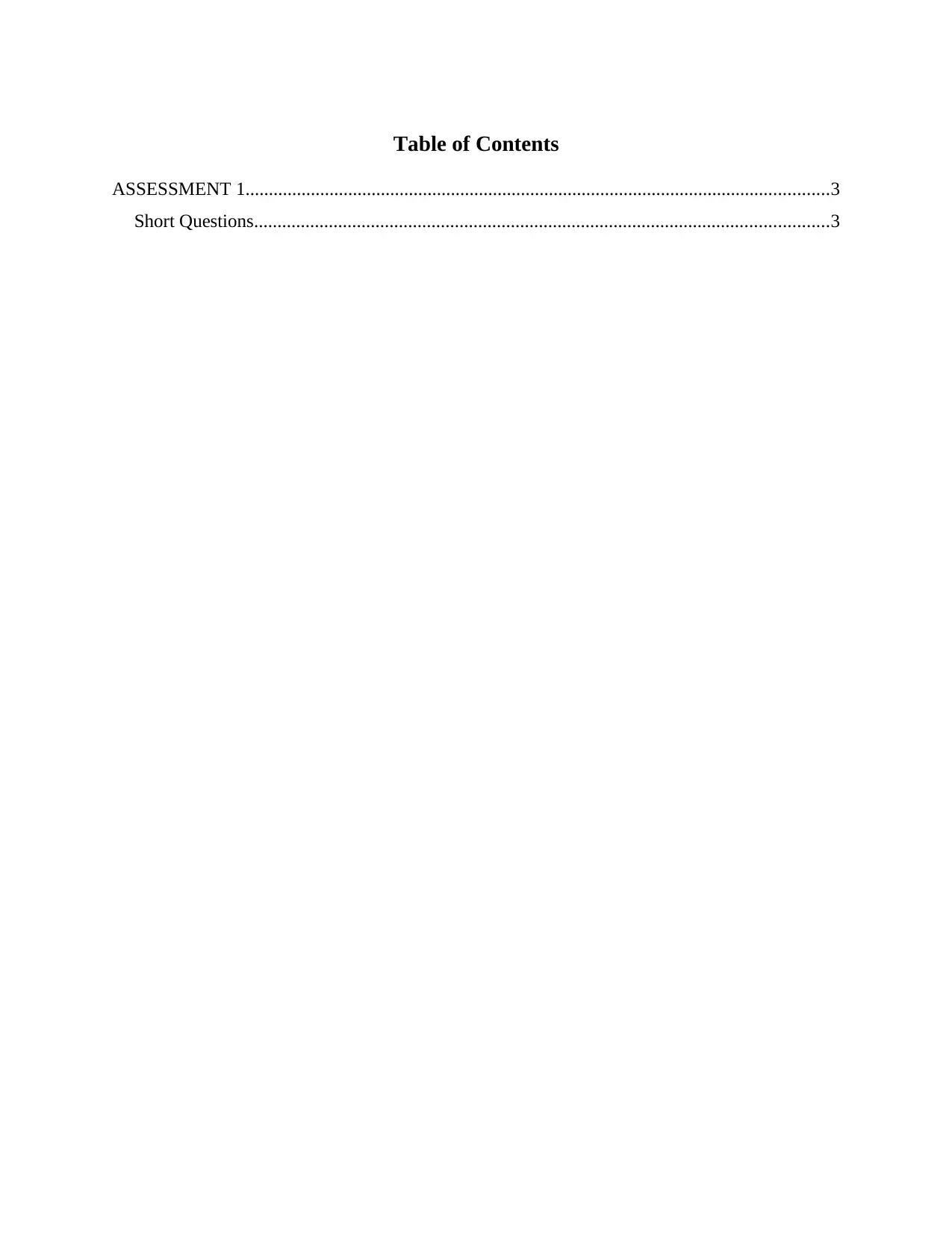
Table of Contents
ASSESSMENT 1.............................................................................................................................3
Short Questions...........................................................................................................................3
ASSESSMENT 1.............................................................................................................................3
Short Questions...........................................................................................................................3
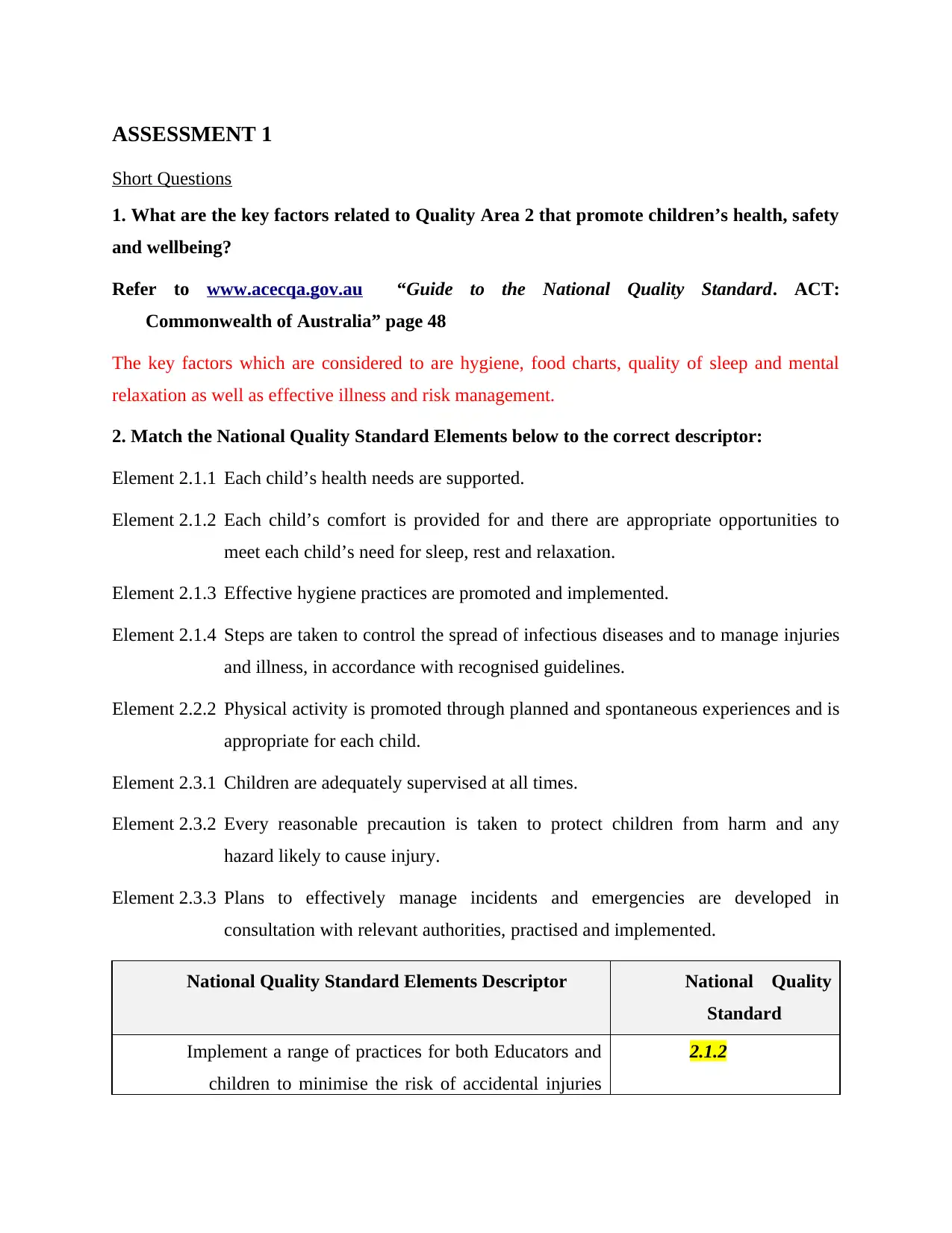
ASSESSMENT 1
Short Questions
1. What are the key factors related to Quality Area 2 that promote children’s health, safety
and wellbeing?
Refer to www.acecqa.gov.au “Guide to the National Quality Standard. ACT:
Commonwealth of Australia” page 48
The key factors which are considered to are hygiene, food charts, quality of sleep and mental
relaxation as well as effective illness and risk management.
2. Match the National Quality Standard Elements below to the correct descriptor:
Element 2.1.1 Each child’s health needs are supported.
Element 2.1.2 Each child’s comfort is provided for and there are appropriate opportunities to
meet each child’s need for sleep, rest and relaxation.
Element 2.1.3 Effective hygiene practices are promoted and implemented.
Element 2.1.4 Steps are taken to control the spread of infectious diseases and to manage injuries
and illness, in accordance with recognised guidelines.
Element 2.2.2 Physical activity is promoted through planned and spontaneous experiences and is
appropriate for each child.
Element 2.3.1 Children are adequately supervised at all times.
Element 2.3.2 Every reasonable precaution is taken to protect children from harm and any
hazard likely to cause injury.
Element 2.3.3 Plans to effectively manage incidents and emergencies are developed in
consultation with relevant authorities, practised and implemented.
National Quality Standard Elements Descriptor National Quality
Standard
Implement a range of practices for both Educators and
children to minimise the risk of accidental injuries
2.1.2
Short Questions
1. What are the key factors related to Quality Area 2 that promote children’s health, safety
and wellbeing?
Refer to www.acecqa.gov.au “Guide to the National Quality Standard. ACT:
Commonwealth of Australia” page 48
The key factors which are considered to are hygiene, food charts, quality of sleep and mental
relaxation as well as effective illness and risk management.
2. Match the National Quality Standard Elements below to the correct descriptor:
Element 2.1.1 Each child’s health needs are supported.
Element 2.1.2 Each child’s comfort is provided for and there are appropriate opportunities to
meet each child’s need for sleep, rest and relaxation.
Element 2.1.3 Effective hygiene practices are promoted and implemented.
Element 2.1.4 Steps are taken to control the spread of infectious diseases and to manage injuries
and illness, in accordance with recognised guidelines.
Element 2.2.2 Physical activity is promoted through planned and spontaneous experiences and is
appropriate for each child.
Element 2.3.1 Children are adequately supervised at all times.
Element 2.3.2 Every reasonable precaution is taken to protect children from harm and any
hazard likely to cause injury.
Element 2.3.3 Plans to effectively manage incidents and emergencies are developed in
consultation with relevant authorities, practised and implemented.
National Quality Standard Elements Descriptor National Quality
Standard
Implement a range of practices for both Educators and
children to minimise the risk of accidental injuries
2.1.2
⊘ This is a preview!⊘
Do you want full access?
Subscribe today to unlock all pages.

Trusted by 1+ million students worldwide
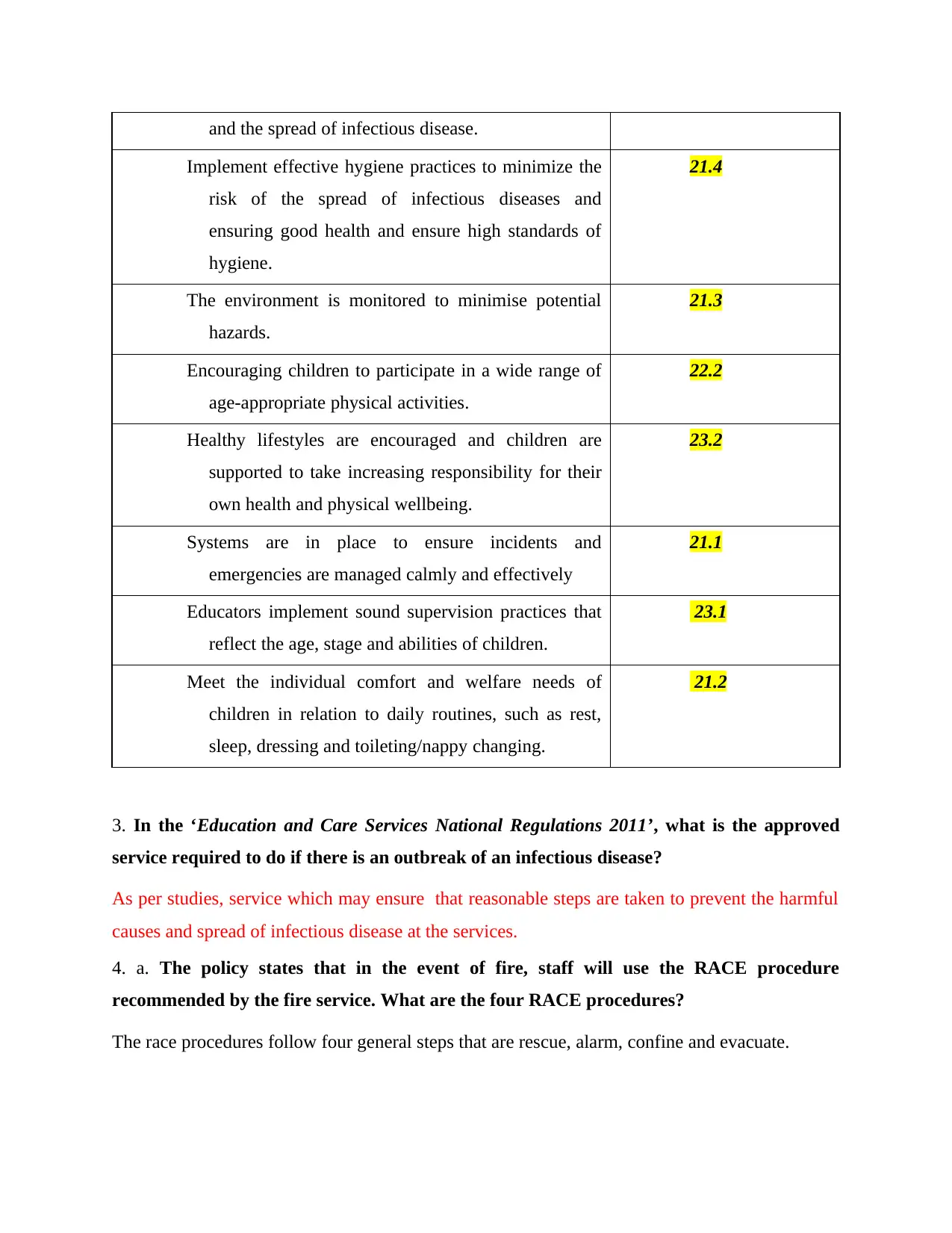
and the spread of infectious disease.
Implement effective hygiene practices to minimize the
risk of the spread of infectious diseases and
ensuring good health and ensure high standards of
hygiene.
21.4
The environment is monitored to minimise potential
hazards.
21.3
Encouraging children to participate in a wide range of
age-appropriate physical activities.
22.2
Healthy lifestyles are encouraged and children are
supported to take increasing responsibility for their
own health and physical wellbeing.
23.2
Systems are in place to ensure incidents and
emergencies are managed calmly and effectively
21.1
Educators implement sound supervision practices that
reflect the age, stage and abilities of children.
23.1
Meet the individual comfort and welfare needs of
children in relation to daily routines, such as rest,
sleep, dressing and toileting/nappy changing.
21.2
3. In the ‘Education and Care Services National Regulations 2011’, what is the approved
service required to do if there is an outbreak of an infectious disease?
As per studies, service which may ensure that reasonable steps are taken to prevent the harmful
causes and spread of infectious disease at the services.
4. a. The policy states that in the event of fire, staff will use the RACE procedure
recommended by the fire service. What are the four RACE procedures?
The race procedures follow four general steps that are rescue, alarm, confine and evacuate.
Implement effective hygiene practices to minimize the
risk of the spread of infectious diseases and
ensuring good health and ensure high standards of
hygiene.
21.4
The environment is monitored to minimise potential
hazards.
21.3
Encouraging children to participate in a wide range of
age-appropriate physical activities.
22.2
Healthy lifestyles are encouraged and children are
supported to take increasing responsibility for their
own health and physical wellbeing.
23.2
Systems are in place to ensure incidents and
emergencies are managed calmly and effectively
21.1
Educators implement sound supervision practices that
reflect the age, stage and abilities of children.
23.1
Meet the individual comfort and welfare needs of
children in relation to daily routines, such as rest,
sleep, dressing and toileting/nappy changing.
21.2
3. In the ‘Education and Care Services National Regulations 2011’, what is the approved
service required to do if there is an outbreak of an infectious disease?
As per studies, service which may ensure that reasonable steps are taken to prevent the harmful
causes and spread of infectious disease at the services.
4. a. The policy states that in the event of fire, staff will use the RACE procedure
recommended by the fire service. What are the four RACE procedures?
The race procedures follow four general steps that are rescue, alarm, confine and evacuate.
Paraphrase This Document
Need a fresh take? Get an instant paraphrase of this document with our AI Paraphraser
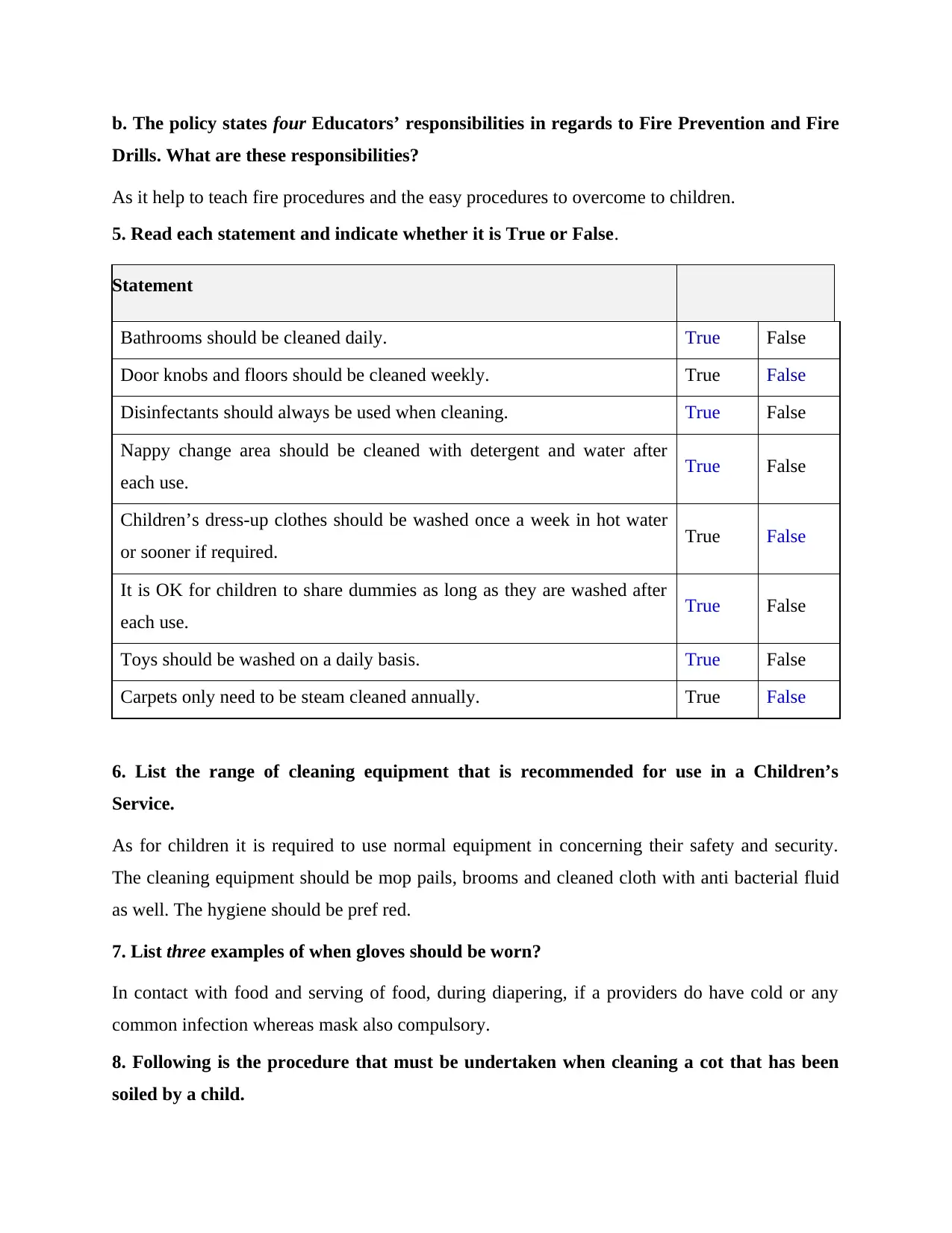
b. The policy states four Educators’ responsibilities in regards to Fire Prevention and Fire
Drills. What are these responsibilities?
As it help to teach fire procedures and the easy procedures to overcome to children.
5. Read each statement and indicate whether it is True or False.
Statement
Bathrooms should be cleaned daily. True False
Door knobs and floors should be cleaned weekly. True False
Disinfectants should always be used when cleaning. True False
Nappy change area should be cleaned with detergent and water after
each use. True False
Children’s dress-up clothes should be washed once a week in hot water
or sooner if required. True False
It is OK for children to share dummies as long as they are washed after
each use. True False
Toys should be washed on a daily basis. True False
Carpets only need to be steam cleaned annually. True False
6. List the range of cleaning equipment that is recommended for use in a Children’s
Service.
As for children it is required to use normal equipment in concerning their safety and security.
The cleaning equipment should be mop pails, brooms and cleaned cloth with anti bacterial fluid
as well. The hygiene should be pref red.
7. List three examples of when gloves should be worn?
In contact with food and serving of food, during diapering, if a providers do have cold or any
common infection whereas mask also compulsory.
8. Following is the procedure that must be undertaken when cleaning a cot that has been
soiled by a child.
Drills. What are these responsibilities?
As it help to teach fire procedures and the easy procedures to overcome to children.
5. Read each statement and indicate whether it is True or False.
Statement
Bathrooms should be cleaned daily. True False
Door knobs and floors should be cleaned weekly. True False
Disinfectants should always be used when cleaning. True False
Nappy change area should be cleaned with detergent and water after
each use. True False
Children’s dress-up clothes should be washed once a week in hot water
or sooner if required. True False
It is OK for children to share dummies as long as they are washed after
each use. True False
Toys should be washed on a daily basis. True False
Carpets only need to be steam cleaned annually. True False
6. List the range of cleaning equipment that is recommended for use in a Children’s
Service.
As for children it is required to use normal equipment in concerning their safety and security.
The cleaning equipment should be mop pails, brooms and cleaned cloth with anti bacterial fluid
as well. The hygiene should be pref red.
7. List three examples of when gloves should be worn?
In contact with food and serving of food, during diapering, if a providers do have cold or any
common infection whereas mask also compulsory.
8. Following is the procedure that must be undertaken when cleaning a cot that has been
soiled by a child.
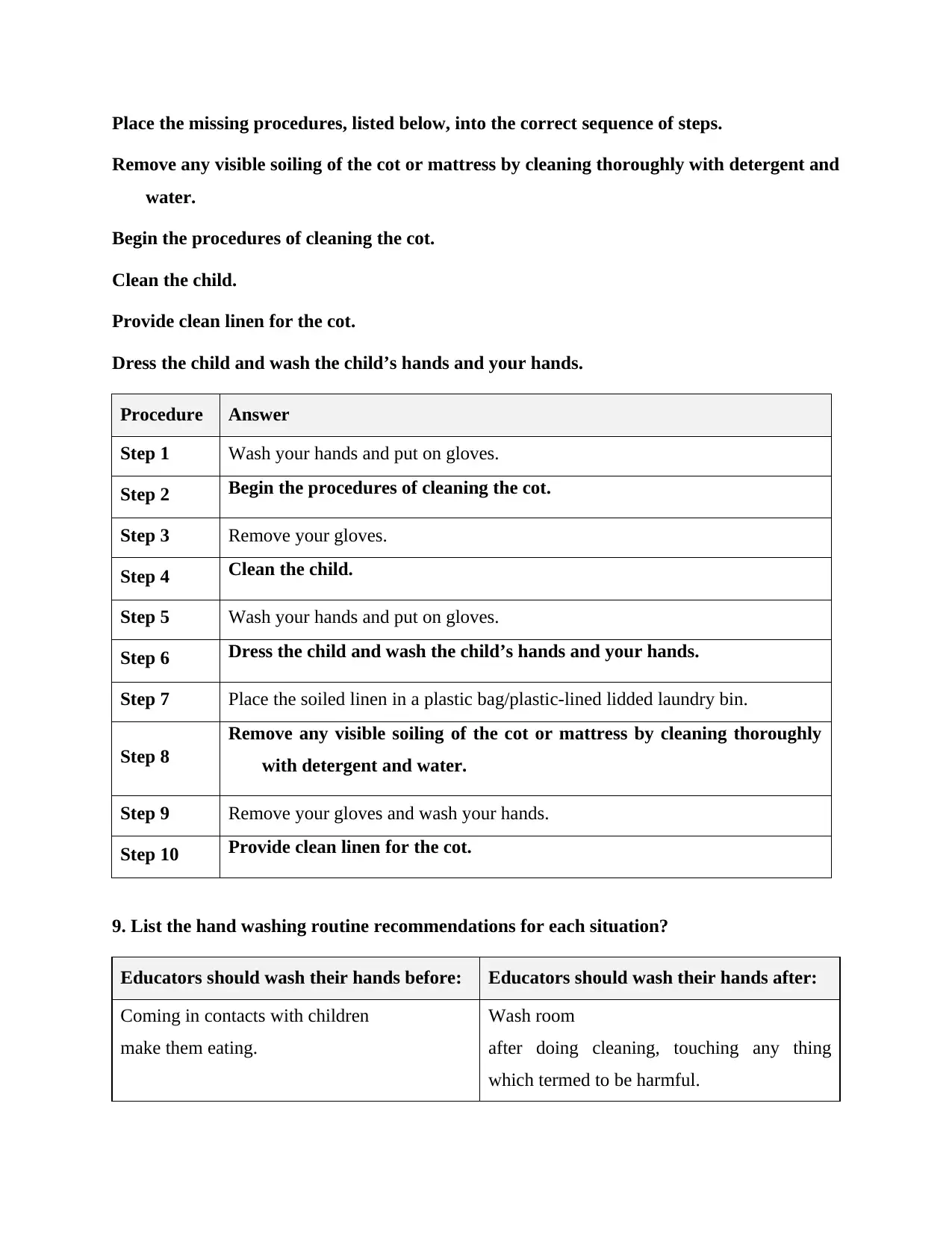
Place the missing procedures, listed below, into the correct sequence of steps.
Remove any visible soiling of the cot or mattress by cleaning thoroughly with detergent and
water.
Begin the procedures of cleaning the cot.
Clean the child.
Provide clean linen for the cot.
Dress the child and wash the child’s hands and your hands.
Procedure Answer
Step 1 Wash your hands and put on gloves.
Step 2 Begin the procedures of cleaning the cot.
Step 3 Remove your gloves.
Step 4 Clean the child.
Step 5 Wash your hands and put on gloves.
Step 6 Dress the child and wash the child’s hands and your hands.
Step 7 Place the soiled linen in a plastic bag/plastic-lined lidded laundry bin.
Step 8
Remove any visible soiling of the cot or mattress by cleaning thoroughly
with detergent and water.
Step 9 Remove your gloves and wash your hands.
Step 10 Provide clean linen for the cot.
9. List the hand washing routine recommendations for each situation?
Educators should wash their hands before: Educators should wash their hands after:
Coming in contacts with children
make them eating.
Wash room
after doing cleaning, touching any thing
which termed to be harmful.
Remove any visible soiling of the cot or mattress by cleaning thoroughly with detergent and
water.
Begin the procedures of cleaning the cot.
Clean the child.
Provide clean linen for the cot.
Dress the child and wash the child’s hands and your hands.
Procedure Answer
Step 1 Wash your hands and put on gloves.
Step 2 Begin the procedures of cleaning the cot.
Step 3 Remove your gloves.
Step 4 Clean the child.
Step 5 Wash your hands and put on gloves.
Step 6 Dress the child and wash the child’s hands and your hands.
Step 7 Place the soiled linen in a plastic bag/plastic-lined lidded laundry bin.
Step 8
Remove any visible soiling of the cot or mattress by cleaning thoroughly
with detergent and water.
Step 9 Remove your gloves and wash your hands.
Step 10 Provide clean linen for the cot.
9. List the hand washing routine recommendations for each situation?
Educators should wash their hands before: Educators should wash their hands after:
Coming in contacts with children
make them eating.
Wash room
after doing cleaning, touching any thing
which termed to be harmful.
⊘ This is a preview!⊘
Do you want full access?
Subscribe today to unlock all pages.

Trusted by 1+ million students worldwide
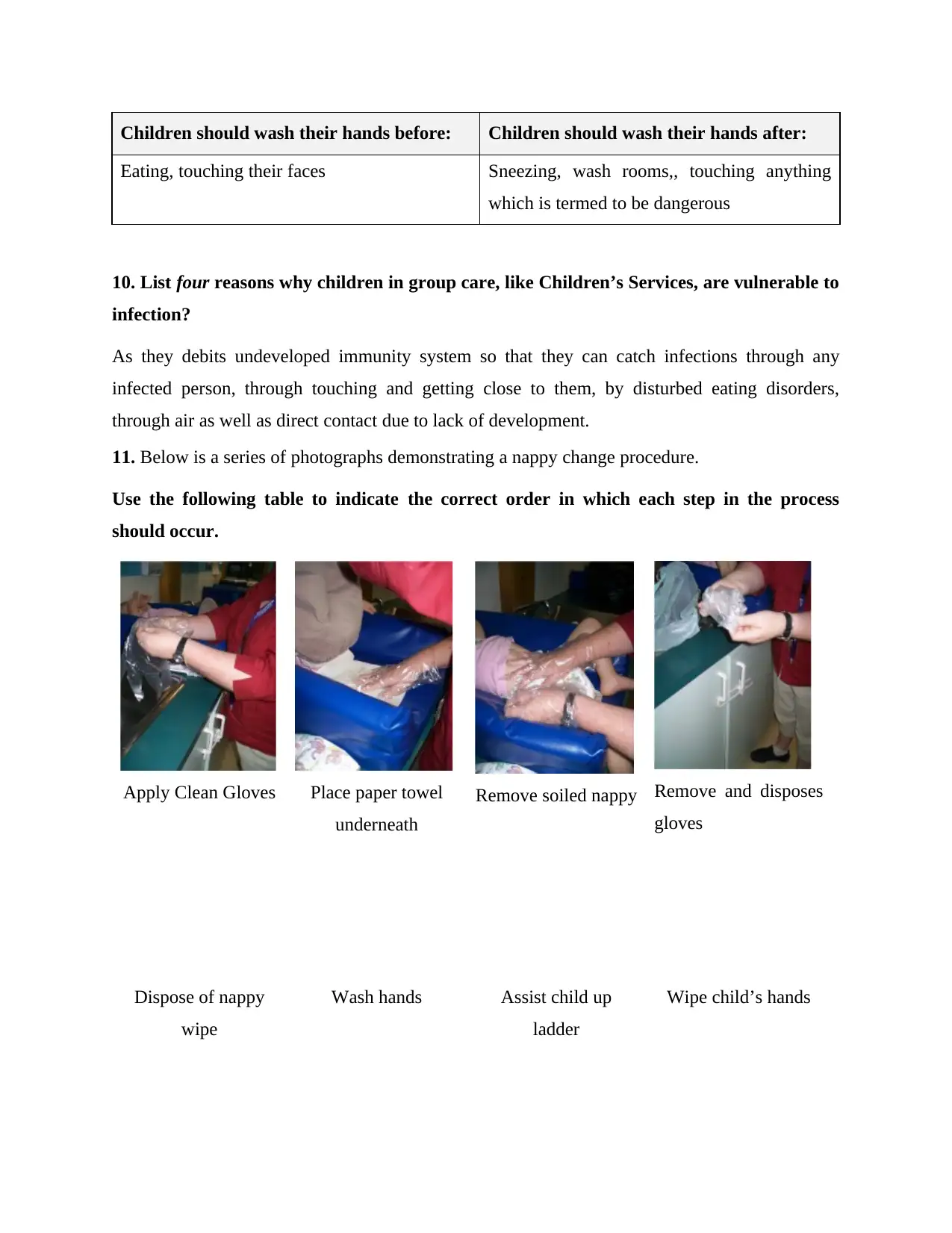
Children should wash their hands before: Children should wash their hands after:
Eating, touching their faces Sneezing, wash rooms,, touching anything
which is termed to be dangerous
10. List four reasons why children in group care, like Children’s Services, are vulnerable to
infection?
As they debits undeveloped immunity system so that they can catch infections through any
infected person, through touching and getting close to them, by disturbed eating disorders,
through air as well as direct contact due to lack of development.
11. Below is a series of photographs demonstrating a nappy change procedure.
Use the following table to indicate the correct order in which each step in the process
should occur.
Apply Clean Gloves Place paper towel
underneath
Remove soiled nappy Remove and disposes
gloves
Dispose of nappy
wipe
Wash hands Assist child up
ladder
Wipe child’s hands
Eating, touching their faces Sneezing, wash rooms,, touching anything
which is termed to be dangerous
10. List four reasons why children in group care, like Children’s Services, are vulnerable to
infection?
As they debits undeveloped immunity system so that they can catch infections through any
infected person, through touching and getting close to them, by disturbed eating disorders,
through air as well as direct contact due to lack of development.
11. Below is a series of photographs demonstrating a nappy change procedure.
Use the following table to indicate the correct order in which each step in the process
should occur.
Apply Clean Gloves Place paper towel
underneath
Remove soiled nappy Remove and disposes
gloves
Dispose of nappy
wipe
Wash hands Assist child up
ladder
Wipe child’s hands
Paraphrase This Document
Need a fresh take? Get an instant paraphrase of this document with our AI Paraphraser
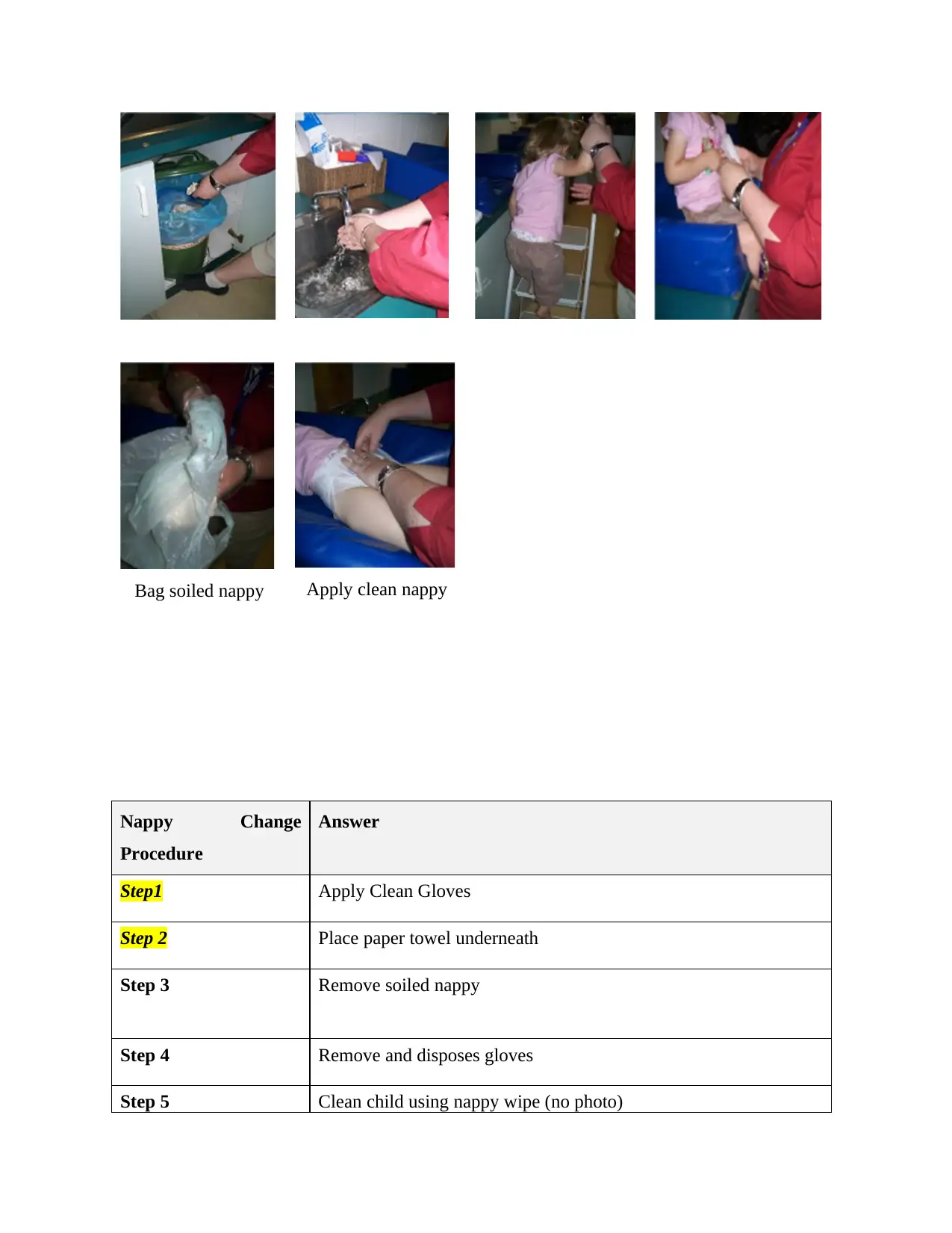
Bag soiled nappy Apply clean nappy
Nappy Change
Procedure
Answer
Step1 Apply Clean Gloves
Step 2 Place paper towel underneath
Step 3 Remove soiled nappy
Step 4 Remove and disposes gloves
Step 5 Clean child using nappy wipe (no photo)
Nappy Change
Procedure
Answer
Step1 Apply Clean Gloves
Step 2 Place paper towel underneath
Step 3 Remove soiled nappy
Step 4 Remove and disposes gloves
Step 5 Clean child using nappy wipe (no photo)
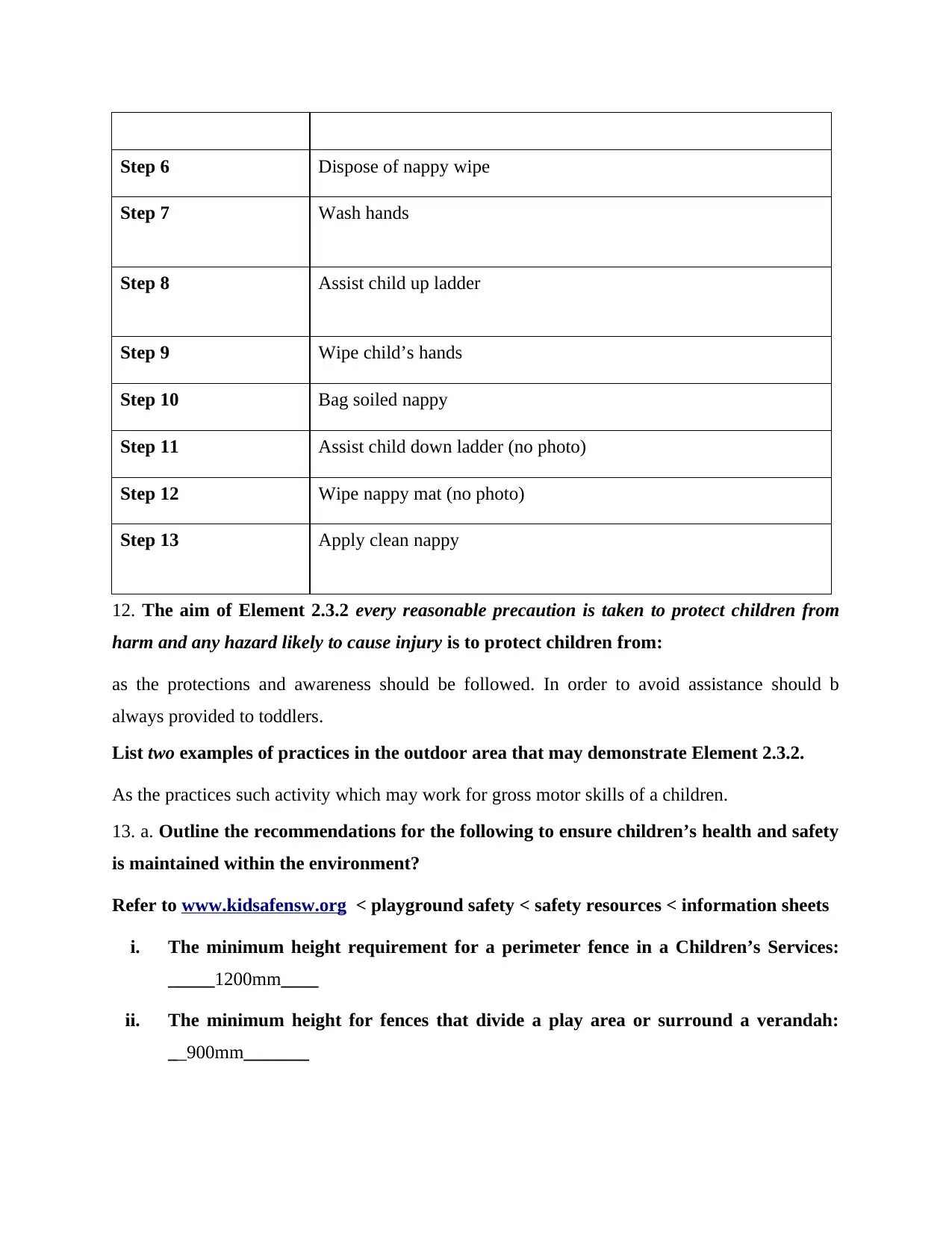
Step 6 Dispose of nappy wipe
Step 7 Wash hands
Step 8 Assist child up ladder
Step 9 Wipe child’s hands
Step 10 Bag soiled nappy
Step 11 Assist child down ladder (no photo)
Step 12 Wipe nappy mat (no photo)
Step 13 Apply clean nappy
12. The aim of Element 2.3.2 every reasonable precaution is taken to protect children from
harm and any hazard likely to cause injury is to protect children from:
as the protections and awareness should be followed. In order to avoid assistance should b
always provided to toddlers.
List two examples of practices in the outdoor area that may demonstrate Element 2.3.2.
As the practices such activity which may work for gross motor skills of a children.
13. a. Outline the recommendations for the following to ensure children’s health and safety
is maintained within the environment?
Refer to www.kidsafensw.org < playground safety < safety resources < information sheets
i. The minimum height requirement for a perimeter fence in a Children’s Services:
_____1200mm____
ii. The minimum height for fences that divide a play area or surround a verandah:
__900mm_______
Step 7 Wash hands
Step 8 Assist child up ladder
Step 9 Wipe child’s hands
Step 10 Bag soiled nappy
Step 11 Assist child down ladder (no photo)
Step 12 Wipe nappy mat (no photo)
Step 13 Apply clean nappy
12. The aim of Element 2.3.2 every reasonable precaution is taken to protect children from
harm and any hazard likely to cause injury is to protect children from:
as the protections and awareness should be followed. In order to avoid assistance should b
always provided to toddlers.
List two examples of practices in the outdoor area that may demonstrate Element 2.3.2.
As the practices such activity which may work for gross motor skills of a children.
13. a. Outline the recommendations for the following to ensure children’s health and safety
is maintained within the environment?
Refer to www.kidsafensw.org < playground safety < safety resources < information sheets
i. The minimum height requirement for a perimeter fence in a Children’s Services:
_____1200mm____
ii. The minimum height for fences that divide a play area or surround a verandah:
__900mm_______
⊘ This is a preview!⊘
Do you want full access?
Subscribe today to unlock all pages.

Trusted by 1+ million students worldwide
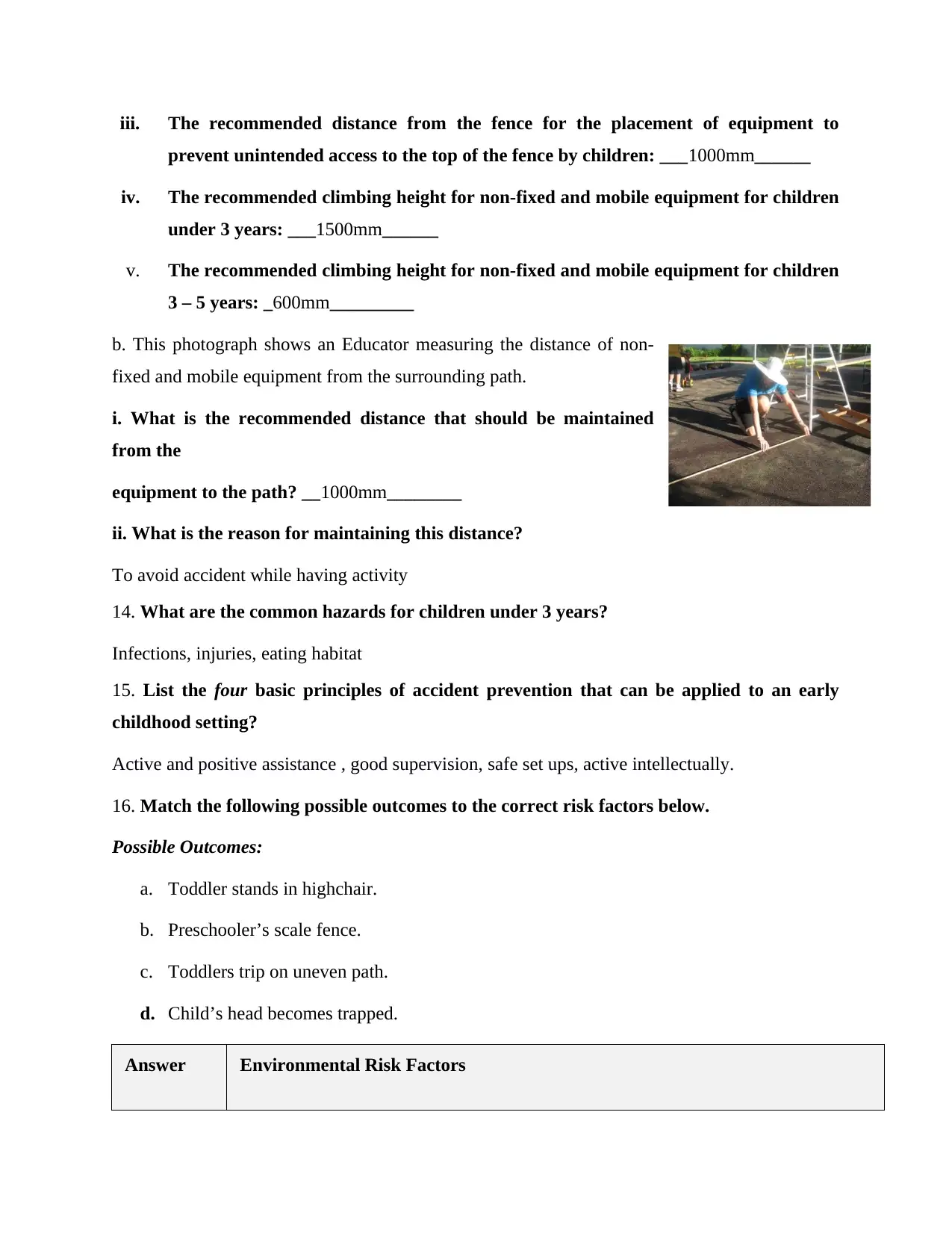
iii. The recommended distance from the fence for the placement of equipment to
prevent unintended access to the top of the fence by children: ___1000mm______
iv. The recommended climbing height for non-fixed and mobile equipment for children
under 3 years: ___1500mm______
v. The recommended climbing height for non-fixed and mobile equipment for children
3 – 5 years: _600mm_________
b. This photograph shows an Educator measuring the distance of non-
fixed and mobile equipment from the surrounding path.
i. What is the recommended distance that should be maintained
from the
equipment to the path? __1000mm________
ii. What is the reason for maintaining this distance?
To avoid accident while having activity
14. What are the common hazards for children under 3 years?
Infections, injuries, eating habitat
15. List the four basic principles of accident prevention that can be applied to an early
childhood setting?
Active and positive assistance , good supervision, safe set ups, active intellectually.
16. Match the following possible outcomes to the correct risk factors below.
Possible Outcomes:
a. Toddler stands in highchair.
b. Preschooler’s scale fence.
c. Toddlers trip on uneven path.
d. Child’s head becomes trapped.
Answer Environmental Risk Factors
prevent unintended access to the top of the fence by children: ___1000mm______
iv. The recommended climbing height for non-fixed and mobile equipment for children
under 3 years: ___1500mm______
v. The recommended climbing height for non-fixed and mobile equipment for children
3 – 5 years: _600mm_________
b. This photograph shows an Educator measuring the distance of non-
fixed and mobile equipment from the surrounding path.
i. What is the recommended distance that should be maintained
from the
equipment to the path? __1000mm________
ii. What is the reason for maintaining this distance?
To avoid accident while having activity
14. What are the common hazards for children under 3 years?
Infections, injuries, eating habitat
15. List the four basic principles of accident prevention that can be applied to an early
childhood setting?
Active and positive assistance , good supervision, safe set ups, active intellectually.
16. Match the following possible outcomes to the correct risk factors below.
Possible Outcomes:
a. Toddler stands in highchair.
b. Preschooler’s scale fence.
c. Toddlers trip on uneven path.
d. Child’s head becomes trapped.
Answer Environmental Risk Factors
Paraphrase This Document
Need a fresh take? Get an instant paraphrase of this document with our AI Paraphraser
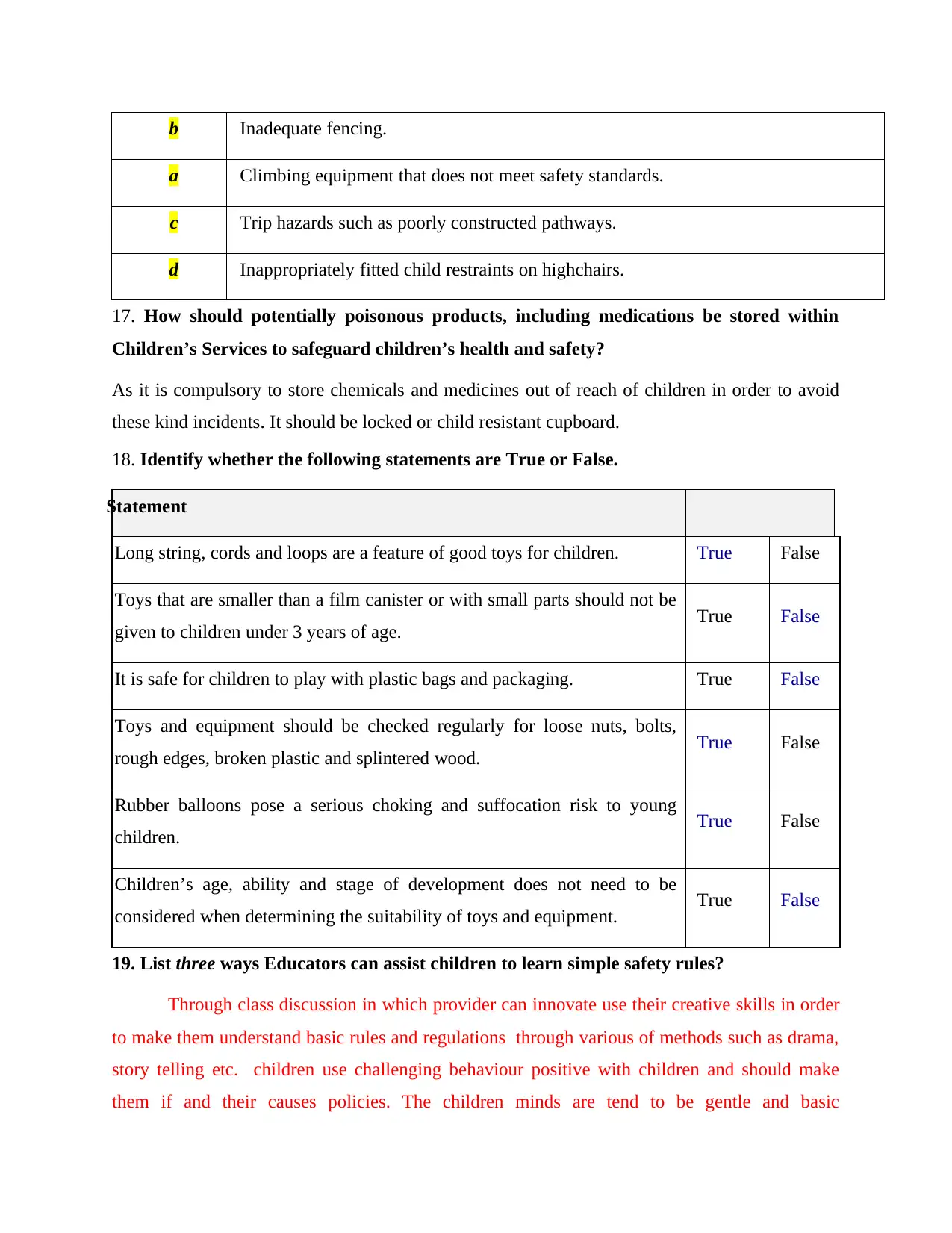
b Inadequate fencing.
a Climbing equipment that does not meet safety standards.
c Trip hazards such as poorly constructed pathways.
d Inappropriately fitted child restraints on highchairs.
17. How should potentially poisonous products, including medications be stored within
Children’s Services to safeguard children’s health and safety?
As it is compulsory to store chemicals and medicines out of reach of children in order to avoid
these kind incidents. It should be locked or child resistant cupboard.
18. Identify whether the following statements are True or False.
Statement
Long string, cords and loops are a feature of good toys for children. True False
Toys that are smaller than a film canister or with small parts should not be
given to children under 3 years of age. True False
It is safe for children to play with plastic bags and packaging. True False
Toys and equipment should be checked regularly for loose nuts, bolts,
rough edges, broken plastic and splintered wood. True False
Rubber balloons pose a serious choking and suffocation risk to young
children. True False
Children’s age, ability and stage of development does not need to be
considered when determining the suitability of toys and equipment. True False
19. List three ways Educators can assist children to learn simple safety rules?
Through class discussion in which provider can innovate use their creative skills in order
to make them understand basic rules and regulations through various of methods such as drama,
story telling etc. children use challenging behaviour positive with children and should make
them if and their causes policies. The children minds are tend to be gentle and basic
a Climbing equipment that does not meet safety standards.
c Trip hazards such as poorly constructed pathways.
d Inappropriately fitted child restraints on highchairs.
17. How should potentially poisonous products, including medications be stored within
Children’s Services to safeguard children’s health and safety?
As it is compulsory to store chemicals and medicines out of reach of children in order to avoid
these kind incidents. It should be locked or child resistant cupboard.
18. Identify whether the following statements are True or False.
Statement
Long string, cords and loops are a feature of good toys for children. True False
Toys that are smaller than a film canister or with small parts should not be
given to children under 3 years of age. True False
It is safe for children to play with plastic bags and packaging. True False
Toys and equipment should be checked regularly for loose nuts, bolts,
rough edges, broken plastic and splintered wood. True False
Rubber balloons pose a serious choking and suffocation risk to young
children. True False
Children’s age, ability and stage of development does not need to be
considered when determining the suitability of toys and equipment. True False
19. List three ways Educators can assist children to learn simple safety rules?
Through class discussion in which provider can innovate use their creative skills in order
to make them understand basic rules and regulations through various of methods such as drama,
story telling etc. children use challenging behaviour positive with children and should make
them if and their causes policies. The children minds are tend to be gentle and basic
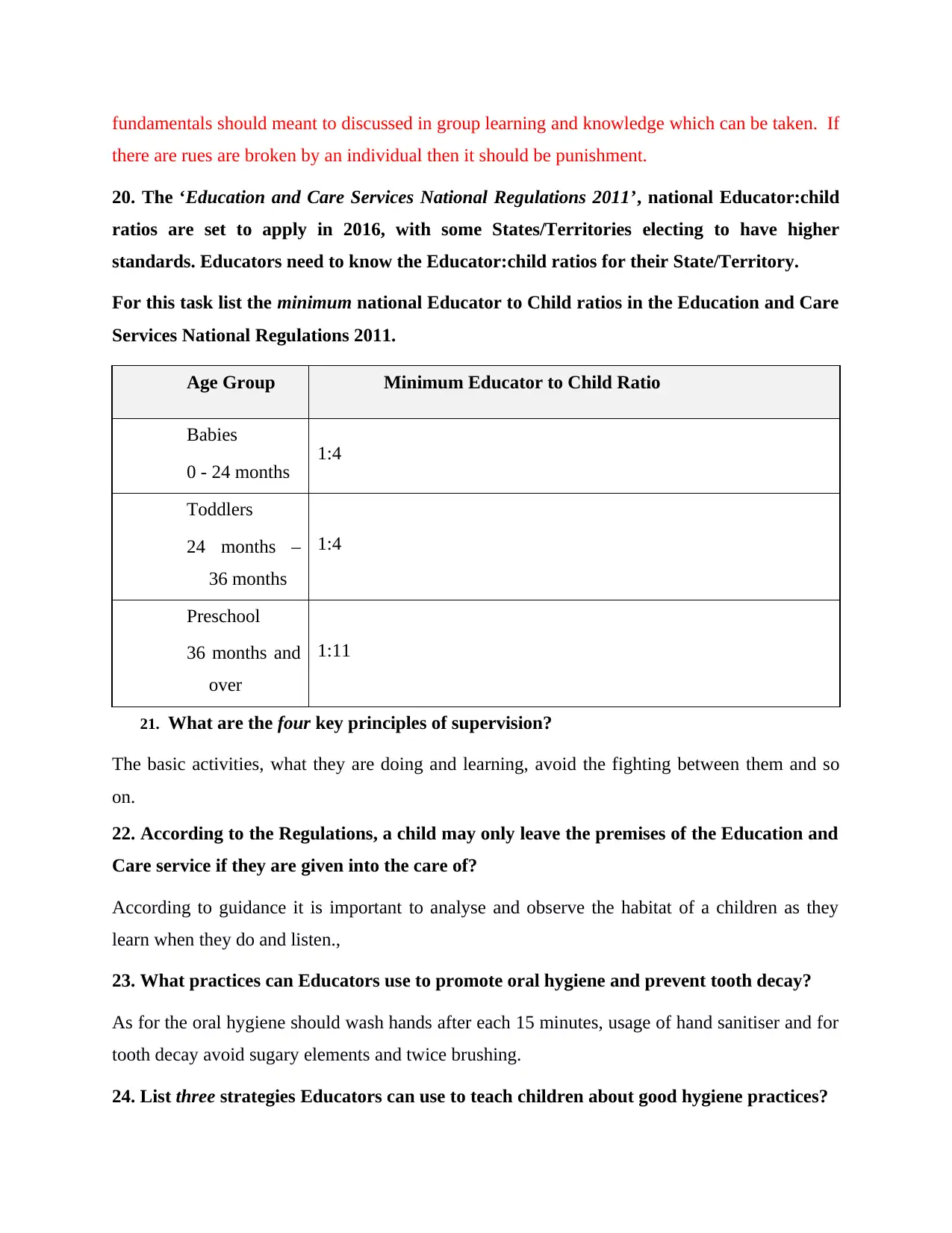
fundamentals should meant to discussed in group learning and knowledge which can be taken. If
there are rues are broken by an individual then it should be punishment.
20. The ‘Education and Care Services National Regulations 2011’, national Educator:child
ratios are set to apply in 2016, with some States/Territories electing to have higher
standards. Educators need to know the Educator:child ratios for their State/Territory.
For this task list the minimum national Educator to Child ratios in the Education and Care
Services National Regulations 2011.
Age Group Minimum Educator to Child Ratio
Babies
0 - 24 months 1:4
Toddlers
24 months –
36 months
1:4
Preschool
36 months and
over
1:11
21. What are the four key principles of supervision?
The basic activities, what they are doing and learning, avoid the fighting between them and so
on.
22. According to the Regulations, a child may only leave the premises of the Education and
Care service if they are given into the care of?
According to guidance it is important to analyse and observe the habitat of a children as they
learn when they do and listen.,
23. What practices can Educators use to promote oral hygiene and prevent tooth decay?
As for the oral hygiene should wash hands after each 15 minutes, usage of hand sanitiser and for
tooth decay avoid sugary elements and twice brushing.
24. List three strategies Educators can use to teach children about good hygiene practices?
there are rues are broken by an individual then it should be punishment.
20. The ‘Education and Care Services National Regulations 2011’, national Educator:child
ratios are set to apply in 2016, with some States/Territories electing to have higher
standards. Educators need to know the Educator:child ratios for their State/Territory.
For this task list the minimum national Educator to Child ratios in the Education and Care
Services National Regulations 2011.
Age Group Minimum Educator to Child Ratio
Babies
0 - 24 months 1:4
Toddlers
24 months –
36 months
1:4
Preschool
36 months and
over
1:11
21. What are the four key principles of supervision?
The basic activities, what they are doing and learning, avoid the fighting between them and so
on.
22. According to the Regulations, a child may only leave the premises of the Education and
Care service if they are given into the care of?
According to guidance it is important to analyse and observe the habitat of a children as they
learn when they do and listen.,
23. What practices can Educators use to promote oral hygiene and prevent tooth decay?
As for the oral hygiene should wash hands after each 15 minutes, usage of hand sanitiser and for
tooth decay avoid sugary elements and twice brushing.
24. List three strategies Educators can use to teach children about good hygiene practices?
⊘ This is a preview!⊘
Do you want full access?
Subscribe today to unlock all pages.

Trusted by 1+ million students worldwide
1 out of 15
Related Documents
Your All-in-One AI-Powered Toolkit for Academic Success.
+13062052269
info@desklib.com
Available 24*7 on WhatsApp / Email
![[object Object]](/_next/static/media/star-bottom.7253800d.svg)
Unlock your academic potential
Copyright © 2020–2025 A2Z Services. All Rights Reserved. Developed and managed by ZUCOL.





